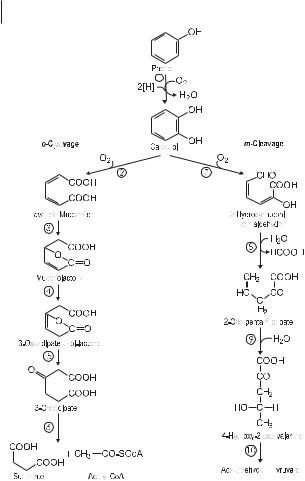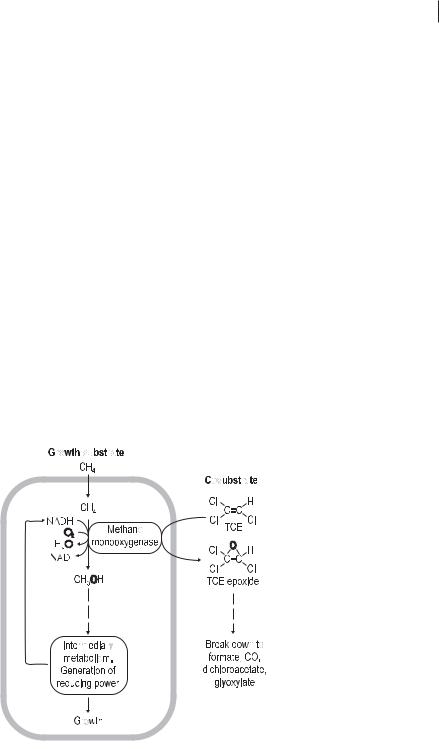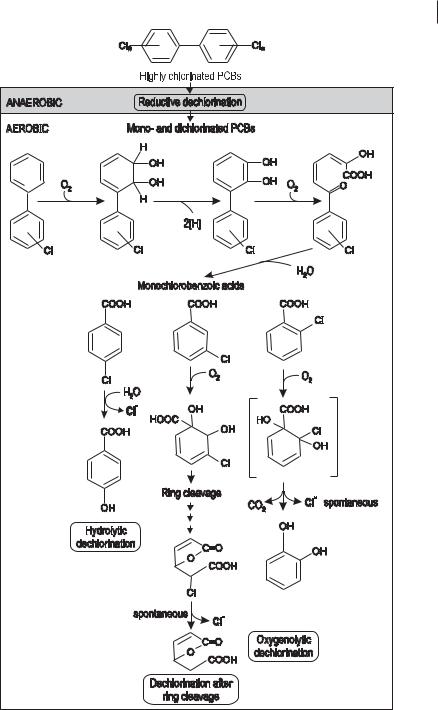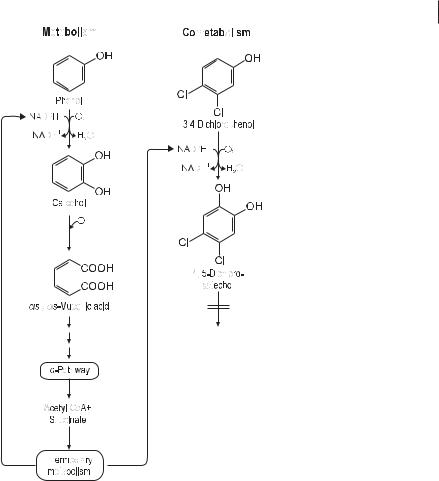
Environmental Biotechnology - Jordening and Winter
.pdf
7.2 Principles of Bacterial Degradation 211
to pathways of degradation of other aromatic hydrocarbons, e.g., of 3- and 4-ring polycyclic aromatic hydrocarbons (PAHs; Kästner 2000).
The introduction of a substituent onto the benzene ring makes it possible to attack sidechains or to oxidize the aromatic ring by alternative mechanisms. The versatility and adaptability of bacteria are based on the existence of catabolic plasmids. Catabolic plasmids have been found that encode enzymes that degrade such naturally occurring aromatics as camphor, naphthalene, and salicylate. Most of the catabolic plasmids are self-transmissible and have a broad host range. The majority of gram-neg- ative soil bacteria isolated from polluted areas possess degradative plasmids, mainly the so-called TOL plasmids. These pseudomonads can grow on toluene, m- and p-xy- lene, and m-ethyltoluene. The main reaction involved in the oxidation of toluene and related arenes is methyl-group hydroxylation. The methyl group of toluene is oxidized stepwise to the corresponding alcohol, aldehyde, and carboxylic group. Benzoate formed or its alkylated derivatives are then oxidized by toluate dioxygenase and decarboxylated to catechol.
The oxygenolytic cleavage of the aromatic ring occurs via ortho or meta cleavage. The significance of the diversity of degradative pathways and of the few key intermediates is still under discussion. Both pathways may be present in one bacterial species. “Whenever an alternative mechanism for the dissimilation of any compound becomes available (ortho versus meta cleavage of ring structures, for example), control of each outcome must be imposed” (Houghton and Shanley 1994). The metabolism of a broad spectrum of aromatic compounds by one species requires the metabolic isolation of intermediates into distinct pathways. This kind of metabolic compartmentation seems to be implemented by metabolic regulation. The key enzymes in the degradation of aromatic substrates are induced and synthesized in appreciable amounts only when the substrate or structurally related compounds are present. The enzyme induction depends on the concentration of the inducing molecules. The substrate-specific concentrations represent the threshold of utilization and growth and are in the micromolar range. A report on the regulation of TOL catabolic pathways was published by Ramos et al. (1997).
Figure 7.7 shows the pathways of oxygenolytic ring cleavage to intermediates of the central metabolism. At the branchpoint, catechol is oxidized by either intradiol ortho cleavage or extradiol meta cleavage. Both ring-cleavage reactions are catalyzed by specific dioxygenases. The product of the ortho cleavage – cis,cis-muconate – is transformed into an unstable enol-lactone, which is in turn hydrolyzed to oxoadipate. This dicarboxylic acid is activated by transfer to CoA, followed by thiolytic cleavage to acetyl-CoA and succinate. Protocatechuate is metabolized by a homologous set of enzymes. The additional carboxylic group is decarboxylated, and the double bond is simultaneously shifted to form oxiadipate enol-lactone. The oxygenolytic meta cleavage yields 2-hydroxymuconic semialdehyde, which is metabolized by hydrolytic enzymes to formate, acetaldehyde, and pyruvate. These are then utilized in the central metabolism. In general, a wealth of aromatic substrates are degraded by a limited number of reactions: hydroxylation, oxygenolytic ring cleavage, isomerization, and hydrolysis. The inducible nature of the enzymes and their substrate specificity enable bacteria having high degradation potential, e.g., pseudomonads and

212 7 Aerobic Degradation of Recalcitrant Organic Compounds by Microorganisms
The two alternative pathways for aerobic degradation of aromatic compounds: ortho and meta cleavage. phenol monooxygenase, catechol 1,2-dioxygenase, muconate-lactonizing enzyme, muconolactone isomerase, oxoadipate enol-lactone hydrolase, oxoadipate suc- cinyl-CoA transferase, catechol 2,3-dioxygenase, hydroxymuconic semialdehyde hydrolase,2-oxopent-4-enoic acid hydrolase, 4-hydroxy-2-oxovalerate aldolase.
rhodococci, to adapt their metabolism to the effective utilization of substrate mixtures in polluted soils and to grow at a high rate.
7.2.4
Extension of Degradative Capacities
7.2.4.1 Cometabolic Degradation of Organopollutants
Cometabolism, the transformation of a substance without nutritional benefit in the presence of a growth substrate, is a common phenomenon in microorganisms. It is the basis of biotransformations (bioconversions) used in biotechnology to convert a

7.2 Principles of Bacterial Degradation 213
substance to a chemically modified form. Microorganisms growing on a particular substrate can gratuitously oxidize a second substrate (cosubstrate). The cosubstrate is not assimilated, but the product can be available as a substrate for other organisms in a mixed culture.
The prerequisites for cometabolic transformations are the enzymes of the growing cells and the synthesis of cofactors necessary for enzymatic reactions, e.g., of hydrogen donors (reducing equivalents, NAD(P)H) for oxygenases. For example, methanotrophic bacteria can use methane or other C1 compounds as a sole source of carbon and energy. They oxidize methane to CO2 via methanol, formaldehyde, and formate. The assimilation requires special pathways, and formaldehyde is the intermediate that is assimilated. The first step in methane oxidation is catalyzed by methane monooxygenase, which attacks the inert CH4 (Fig. 7.8). Methane monooxygenase is unspecific and also oxidizes various other compounds, e.g., alkanes, aromatic compounds, and trichloroethylene (TCE). The proposed mechanism of TCE transformation according to Henry and Grbic-Gallic (1994) is shown in Figure 7.8. TCE is oxidized to an epoxide that is excreted from the cell. The unstable oxidation product breaks down to compounds that can be used by other microorganisms.
Methanotrophic bacteria are indigenous aerobic bacteria in soils and aquifers, but methane has to be added as growth substrate and inducer for the development of methanotrophic biomass, which limits their usefulness in bioremediation.
Cometabolism of chloroaromatics is a widespread activity of bacteria in mixtures of industrial pollutants. Knackmuss (1997) demonstrated that the cometabolic transformation of 2-chlorophenol gives rise to dead-end metabolites, e.g., 3-chlorocate- chol. This reaction product can be autoxidized or polymerized in soils to humic-like
Fig. 7.8 Cometabolic degradation of trichloroethylene (TCE) by the methane monooxygenase system of methanotrophic bacteria.

214 7 Aerobic Degradation of Recalcitrant Organic Compounds by Microorganisms
structures. Irreversible binding of dead-end metabolites may fulfill the function of detoxification. (The accumulation of dead-end products within microbial communities under selective pressure is the basis for the evolution of new catabolic traits (Reinecke 1994).)
7.2.4.2Overcoming Persistent Pollutants by Cooperation Between Anaerobic and Aerobic Bacteria
As a rule, the recalcitrance of organic pollutants increases with the degree of halogenation. Substitution of halogen as well as nitro and sulfo groups on the aromatic ring is accompanied by increasing electrophilicity. These compounds resist electrophilic attack by oxygenases of aerobic bacteria. Compounds that persist under oxic conditions include PCBs (polychlorinated biphenyls), chlorinated dioxins, and some pesticides, e.g., DDT and lindane.
To overcome the relatively high persistance of halogenated xenobiotics, reductive attack by anaerobic bacteria is important. Degradation of environmental pollutants by anaerobic bacteria is the subject of Chapter 8 of this volume. Reductive dehalogenation as the first step in the degradation of higher halogenated compounds by anaerobic bacteria is a significant finding, because it is either a gratuitous reaction or a new type of anaerobic respiration. The process reduces the degree of chlorination and thus makes the products more accessible to mineralization by aerobic bacteria.
A sequence of anaerobic and aerobic bacterial activities for the mineralization of chlorinated xenobiotics is shown in Figure 7.9. PCBs, which are selected as an example for the degradation of halogenated compounds, are well-studied substances. The implementation of the reactions depends on the structure of the chemical compounds as well as on the microorganisms and conditions in a polluted ecosystem. We have to distinguish between the general degradation potential and the actual conditions necessary for it to occur. Reductive dehalogenation, the first step in PCBs degradation, requires anaerobic conditions and organic substrates acting as electron donors. The PCBs function as electron acceptors to allow the anaerobic bacteria to transfer electrons to these compounds. Anaerobic bacteria capable of catalyzing reductive dehalogenation seem to be relatively ubiquitous in nature. Most dechlorinating cultures are mixed cultures (consortia). Anaerobic dechlorination is always incomplete; products are diand monochlorinated biphenyls. These products can be metabolized further by aerobic microorganisms. The substantial decrease in concentration of PCBs by sequential anaerobic and aerobic treatment has been demonstrated in the laboratory (Abramowicz 1990).
The principles of aerobic dehalogenation reactions of chloroaromatics are illustrated in Figure 7.9. Hydrolytic dechlorination has been elucidated by using 4-chlo- robenzoate as the substrate for Pseudomonas and Nocardia spp.. A halidohydrolase is capable of replacing the halogen substituent by a hydroxy group originating from water. This type of reaction seems to be restricted to halobenzoates substituted in the para position. Dechlorination after ring cleavage is a common reaction in the ortho pathway of chlorocatechols, catalyzed by catechol 1,2-dioxygenases to produce chloromuconates. Oxygenolytic dechlorination is a rare fortuitous reaction catalyzed

7.2 Principles of Bacterial Degradation 215
Principles of dehalogenation: degradation of PCBs by a sequence of anaerobic and aerobic bacterial processes.

216 7 Aerobic Degradation of Recalcitrant Organic Compounds by Microorganisms
by monoand dioxygenases. During this reaction, the halogen substituent is replaced by an oxygen of O2.
Higher-chlorinated phenols, e.g., pentachlorophenol, have been widely used as biocides. Several aerobic bacteria that degrade chlorophenols have been isolated (Flavobacterium, Rhodococcus). The degradation mechanism has been elucidated in some instances (McAllister et al. 1996). For example, Rhodococcus chlorophenolicus degrades pentachlorophenol through a hydrolytic dechlorination and three reductive dechlorinations, producing trihydroxybenzene. The potential of these bacteria is limited to some specialists and to specific conditions. Therefore, the use of polychlorinated phenols has been banned in many countries.
7.3
Degradative Capacities of Fungi
As saprophytic decomposers, members of the fungal kingdom permeate the living scene. An enormous number of fungi exist, perhaps as many as 1.5 million species, a magnitude that is comparable only with the huge biodiversity of insects. Fungi exist in a wide range of habitats: in freshwater and the sea, in soil, litter, decaying remains of plants and animals, in dung, and in living organisms. Fungi have been estimated to account for more than 60% of the living microbial biomass in certain habitats (e.g., forest and other soils; Dix and Webster 1995). Last but not least, fungi possess important degradative capabilities that have implications for the recycling of recalcitrant polymers (e.g., lignin) and for the elimination of hazardous wastes from the environment. Below, some aspects of the fungal degradation of organopollutants are discussed.
7.3.1
Metabolism of Organopollutants by Microfungi
For practical reasons, yeasts and molds can be grouped together into the microfungi (Gravesen et al. 1994). Taxonomically, they belong to the ascomycetous, deuteromycetous, and zygomycetous fungi. Yeasts preferentially grow as single cells or form pseudomycelia, whereas molds typically grow as mycelia-forming real hyphae. Microfungi colonize various habitats, and some genera are typical soil microorganisms (Aspergillus, Penicillium, Trichoderma, Candida, Trichosporon).
7.3.1.1 Aliphatic Hydrocarbons
Biodegradation of aliphatic hydrocarbons occurring in crude oil and petroleum products has been investigated well, especially for yeasts. The n-alkanes are the most widely and readily utilized hydrocarbons, with those between C10 and C20 being most suitable as substrates for microfungi (Bartha 1986). However, the biodegradation of n-alkanes having chain lengths up to n-C24 has also been demonstrated (Fritsche and Hofrichter 2000). Typical representatives of alkane-utilizing yeasts include

7.3 Degradative Capacities of Fungi 217
Candida lipolytica, C. tropicalis, Rhodoturula rubra, and Aureobasidion (Trichosporon) pullulans; examples of molds using n-alkanes as growth substrates are Cunninghamella blakesleeana, Aspergillus niger, and Penicillium frequentans (Watkinson and Morgan 1990). In this context, one should keep in mind that in the 1960s and 1970s British Petrol (BP) and other companies ran large plants for the production of single-cell protein (SCP) from the wax fraction of crude oil. BP used two yeasts, Candida lipolytica and C. tropicalis to produce a product called Toprina that was marketed as a replacement for fish meal in high-protein feeds.
Yeast and molds preferentially oxidize long-chain n-alkanes, because short-chain liquid alkanes (n-C5–C9) are toxic. The toxic effects of short-chain alkanes can be reversed by adding nontoxic long-chain hydrocarbons. Thus, Candida spp. grew on n- octane if 10% pristane was present (Britton 1984). The soil fungus Penicillium frequentans is capable of utilizing monohalogenated n-alkanes (e.g., 1-fluorotetrade- cane) and dehalogenates them completely. Since all aliphatic hydrocarbons are nearly insoluble in water, fungi produce biosurfactants, which disperse the substrates into oil-in-water emulsions, increasing the interfacial area and thereby enhancing the bioavailability of hydrocarbons (Hommel 1990).
In microfungi, the alkanes are mostly terminally oxidized to their corresponding primary alcohols (n-alkan-1-ols) by a monooxygenase enzyme complex containing cytochrome P450 and NAD(P)H–cytochrome P450 reductase (Britton 1984):
R–CH2–CH3 + O2 + NAD(P)H2 → R–CH2–CH2OH + NAD(P) + H2O
Subterminal oxidation yielding various secondary alcohols is a rarer type of primary attack on n-alkanes and has been documented in certain molds (Aspergillus spp., Fusarium spp.; Rehm and Reiff 1982). Peroxisomal enzymes carry out the remaining degradation of alkanols to intermediates that are transferable to the mitochondria (Britton 1984). After terminal oxidation, the alcohol produced is normally oxidized to the corresponding aldehyde and fatty acid by means of pyridine nucleo- tide-linked dehydrogenases. In some Candida spp. and several molds, alcohol oxidases have been shown to be present instead of dehydrogenases. Secondary alcohols resulting from subterminal oxidation systems are oxidized to the corresponding ester and hydrolytically cleaved to acetic acid and an alcohol, which is subsequently also converted to a fatty acid. The fatty acids produced are always further metabolized by â-oxidation and finally to CO2 via the tricarboxylic acid cycle.
In contrast to n-alkanes, fungi cannot utilize branched alkanes or cycloaliphatic compounds as sole sources of carbon and energy (Britton 1984; Morgan and Watkinson 1994).
7.3.1.2Aromatic Compounds
Several yeasts and molds can utilize aromatic compounds as growth substrates (Table 7.2), but more important is their ability to convert aromatic substances cometabolically. Figure 7.10 illustrates this principle with the example of 3,4-dichlorophe- nol oxidation in the presence of phenol as the actual growth substrate in the soil-

2187 Aerobic Degradation of Recalcitrant Organic Compounds by Microorganisms
Table 7.2 Some species of yeasts and molds that utilize aromatic compounds as growth substrates (according to Fritsche and Hofrichter 2000).
Species Growth substrates
Yeasts |
|
Aureobasidium pullulans |
phenol, o-cresol, p-cresol, benzoic acid |
Candida maltosa |
phenol, catechol, benzoic acid |
Exophiala jeanselmei |
phenol, styrene, benzoic acid, acetophenone |
Rhodotorula glutinis |
phenol, m-cresol, benzoic acid |
Trichosporon cutaneum |
phenol, p-cresol, benzoic acid, salicylic acid |
Molds |
|
Aspergillus niger |
2,4-dichloro-phenoxy acetic acid, benzoic acid, salicylic acid, |
|
monochlorobenzoic acids |
Aspergillus fumigatus |
phenol, p-cresol, 4-ethylphenol, phenylacetic acid |
Fusarium flocciferum |
phenol, resorcinol |
Penicillium frequentans |
phenol, p-cresol, resorcinol, phloroglucinol, anisole, benzyl |
|
alcohol, benzoic acid, salicylic acid, gallic acid, phenylacetic |
|
acid, 1-phenylethanol acetophenone |
Penicillium simplicissimum |
phenol, phloroglucinol, monofluorophenols |
|
|
dwelling mold Penicillium frequentans (Hofrichter et al. 1994). Whereas phenol is completely converted into biomass, carbon dioxide, and water, the chlorinated phenol is only transformed to a catechol that cannot be further degraded and remains as a dead-end product.
Table 7.2 is a partial list of microfungal species that have been shown to utilize aromatic compounds as sole sources of carbon and energy. Some species – such as the soil yeast Trichosporon cutaneum – possess specific energy-dependent uptake systems for aromatic substrates (e.g., for phenol; Mörtberg and Neujahr 1985). They cleave aromatic rings exclusively via the ortho pathway analogously to many bacteria (Wright 1993; compare Figure 7.7). To this end, they first insert activating hydroxyl groups into the aromatic ring. Phenol hydroxylase, benzoate-4-hydroxylase, and 4- hydroxybenzoate-3-hydroxylase are examples of enzymes hydroxylating the aromatic ring in the ortho or para position. They are NADPH2-dependent monooxygenases and have been described in both yeasts and molds (e.g., Trichosporon cutaneum, Penicillium frequentans, Aspergillus fumigatus; Fritsche and Hofrichter 2000). After activation, dioxygenases cleave the aromatic ring to form cis,cis-muconic acids. The latter are lactonized, isomerized, and hydrolyzed, resulting in the formation of â-ketoadi- pate, which is degraded to CO2 via the tricarboxylic acid cycle.
Hydroxylating and ring-cleaving enzymes of yeasts and molds are relatively unspecific and usually convert also related compounds, including halogenated and nitro aromatics. Thus, depending on the substitution pattern, fluoroand chlorophenols are converted to the corresponding catechols, cleaved to halogenated muconic acids, or dehalogenated. The alkaneand phenol-utilizing mold Penicillium frequentans

7.3 Degradative Capacities of Fungi 219
Fig. 7.10 Principle of cometabolic transformation of organopollutants by microfungi: hydroxylation of 3,4-dichlorophenol by the mold Penicillium frequentans growing on phenol.
has been shown to degrade a mixture of phenol, p-cresol, and two chlorophenols without additional growth substrate in soil. In addition to halogenated aromatic compounds, microfungi transform numerous other aromatic organopollutants cometabolically, including polycyclic aromatic hydrocarbons (PAHs) and biphenyls, dibenzofurans, nitro aromatics, various pesticides, and plasticizers (Fritsche and Hofrichter 2000). Typical fungal transformations are glycosylations, hydroxylations and ring cleavage, methoxylations, and the reduction of nitro groups to amino groups (Table 7.3). Hydroxylation reactions are particular important for elimination of organopollutants in soils, because they increase the reactivity of the molecules and make their subsequent covalent coupling to humus possible (Kästner 2000). The introduction of hydroxyl groups is often catalyzed by relatively unspecific cytochrome P450-containing monooxygenases which, for example, oxidize benzo(a)pyrene in Aspergillus ochraceus (Dutta et al. 1983).

2207 Aerobic Degradation of Recalcitrant Organic Compounds by Microorganisms
Table 7.3 Selected organopollutants and their metabolites that are cometabolically formed by yeasts and molds (according to Fritsche and Hofrichter 2000).
Organopollutants |
Metabolites |
|
|
Monoand dichlorophenols |
chlorocatecholsa–c, chloroguaiacolsc, chlorinated muconic acidsc, |
|
chloridec |
Pentachlorophenol |
pentachloroanisolef |
Fluorophenols |
fluorocatecholsc, fluorinated muconic acidsc, fluoridec |
2,4-Dinitrophenol |
monoaminonitrophenolse |
2,4,6-Trinitrotoluene |
aminodinitrotoluenesc–e, hydroxylamino dinitrotoluenesc–e |
Pyrene |
1-pyrenolc–e, 1-methoxypyrened, dihydroxypyrenesc |
Benzo(a)pyrene |
hydroxybenzo(a)pyrenesd |
Dibenzofurane |
2,3-dihydroxybenzofuranb, ring-cleavage productsb |
Biphenyl |
4,4b-dihydroxybiphenyld |
Atrazine |
N-dealkylated productsc–f |
a Rhodotorula spp. b Trichosporon spp c Penicillium spp. d Aspergillus spp. e Fusarium spp.
f Trichoderma spp.
7.3.2
Degradative Capabilities of Basidiomycetous Fungi
Basidiomycetous fungi form characteristic macroscopic fruiting bodies and belong, like certain ascomycetes, to the macrofungi (Dix and Webster 1995). Colloquially, many of these fungi (especially the edible ones) are called mushrooms or toadstools. They preferably colonize the litter layer in woodlands and pastures as well as lignocellulosic materials (wood, straw). From the ecophysiological point of view, they can be broadly classified into litter-decomposing, wood-decaying, and mycorrhizal fungi, although there is, inevitably, some overlap of roles. Basidiomycetes can form huge mycelial clones, and it has been estimated that they can extend over an area of several hectares while reaching an age of 1500 y and a mycelial biomass of 100 t (Dix and Webster 1995).
7.3.2.1 The Ligninolytic Enzyme System
Lignin, like cellulose, is a major component of plant materials and the most abundant form of aromatic carbon in the biosphere. It provides strength and rigidity to the cell walls of all vascular plants (club mosses, ferns, horsetails, seed plants) by acting as a glue between the cellulose and hemicellulose fibers. In addition, lignin forms a barrier against microbial destruction and protects the readily degradable carbohydrates. From the chemical point of view, lignin is a heterogeneous, optically inactive polymer consisting of phenylpropanoid subunits that are linked by various
